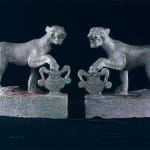Pair of Roman Bronze Ornaments in the Form of Panthers, 1st Century CE - 3rd Century CE
Bronze
6.5 x 5
X.0186
These decorative ornaments, modeled in the forms of panthers resting one of their front paw on a vase, are thought to have once decorated a chariot. If this was the...
These decorative ornaments, modeled in the forms of panthers resting one of their front paw on a vase, are thought to have once decorated a chariot. If this was the case, it was almost surely a ceremonial quadriga, for racing and war chariots would not have been embellished with such beautiful adornments. We can imagine a victorious general parading through the streets of Rome. Crowds gather along the streets, squeezing together to applaud his courage and catch a glimpse of him strolling by in a luxurious chariot. Since speed and mobility were essentially unimportant, every available luxury could be bestowed upon a ceremonial quadriga. Imagine gold and ivory inlays decorating the sides with scenes of the general’s victorious conquest. Elaborate bronze fittings are well known in the museums of the world, as well as trappings, revealing that the horses that pulled these chariots were equally embellished. These bronze fittings depicting prowling panthers are one such splendid example. Ancient symbols of strength and power, these panthers must have symbolized the fortitude and bravery of the rider, be it an emperor or a military general.
With open, high, curving bases, this pair of feline ornaments would have presumably once decorated the upper railing of an ancient chariot. The composition of each piece is masterful: the body of the panther manages to fill the entire space without seeming compacted in any way, from the tip of the curved tail on one end of the fitting to the front paw resting on the vase at the edge of the other end. The vases, which appear to be amphoras with spiraling scroll handles, are flat, contrasting to the three-dimensional modeling of the panthers. The panthers stand tall, their heads held high in the air with open mouths and protruding tongues. Incised lines around the neck reproduce the texture of their furry manes, while the folds around their eyes are marvelously captured. Also impressive is the ferocious set of fangs that fill their mouths. Their large, powerful legs feature indications of the musculature and tendons and their paws feature individual toes and claws. The whole of their two bodies have been incised with a motif of dashes and circles that recreates both the textual feeling of the fur as well as the spotted pattern. A pair of undulating lines along the side of the base indicates that no decorative detail was overlooked. Nails would have been driven through the hole in the back of the fittings, opposite the tail and paws, in order to secure this ornament into place along the railing of an ancient ceremonial chariot. Although the wooden frame of this quadriga has longs since deteriorated, we can still imagine the luxurious nature of such a ceremonial vehicle based the beauty on the few decorative elements that have survived.
With open, high, curving bases, this pair of feline ornaments would have presumably once decorated the upper railing of an ancient chariot. The composition of each piece is masterful: the body of the panther manages to fill the entire space without seeming compacted in any way, from the tip of the curved tail on one end of the fitting to the front paw resting on the vase at the edge of the other end. The vases, which appear to be amphoras with spiraling scroll handles, are flat, contrasting to the three-dimensional modeling of the panthers. The panthers stand tall, their heads held high in the air with open mouths and protruding tongues. Incised lines around the neck reproduce the texture of their furry manes, while the folds around their eyes are marvelously captured. Also impressive is the ferocious set of fangs that fill their mouths. Their large, powerful legs feature indications of the musculature and tendons and their paws feature individual toes and claws. The whole of their two bodies have been incised with a motif of dashes and circles that recreates both the textual feeling of the fur as well as the spotted pattern. A pair of undulating lines along the side of the base indicates that no decorative detail was overlooked. Nails would have been driven through the hole in the back of the fittings, opposite the tail and paws, in order to secure this ornament into place along the railing of an ancient ceremonial chariot. Although the wooden frame of this quadriga has longs since deteriorated, we can still imagine the luxurious nature of such a ceremonial vehicle based the beauty on the few decorative elements that have survived.



